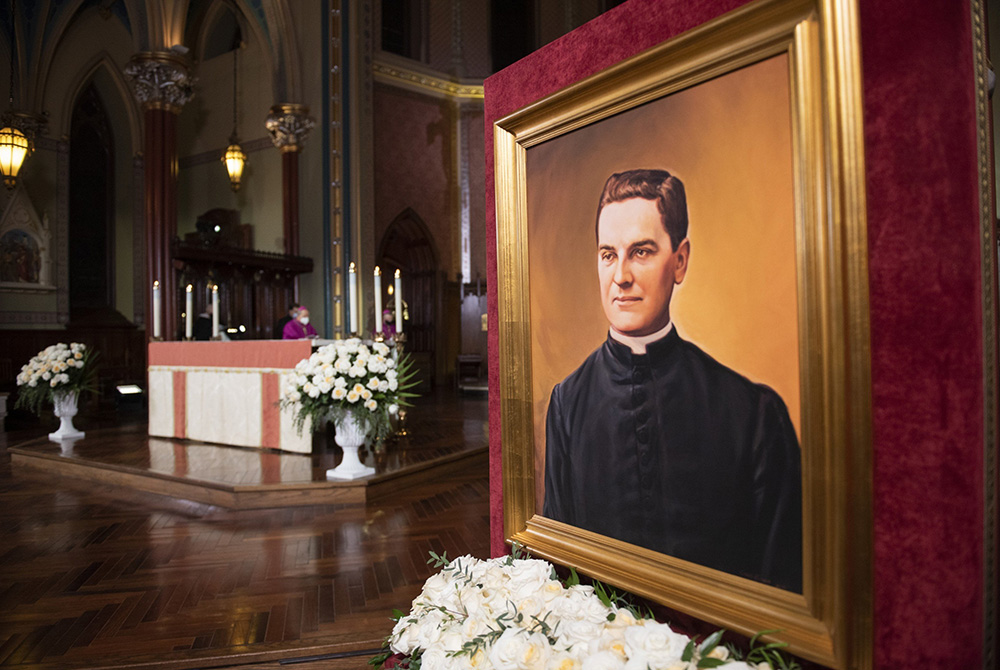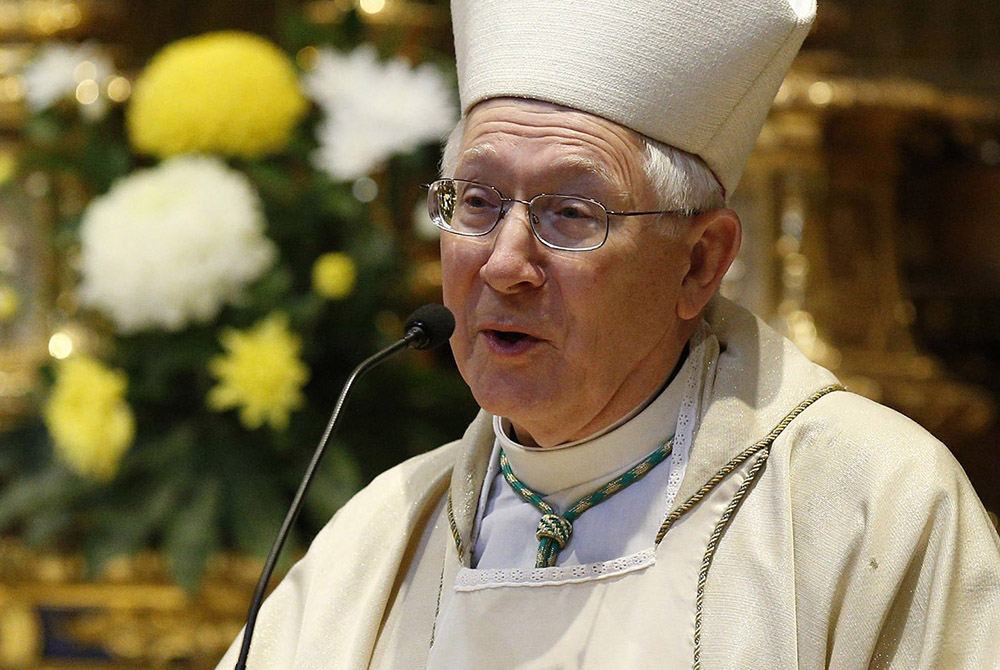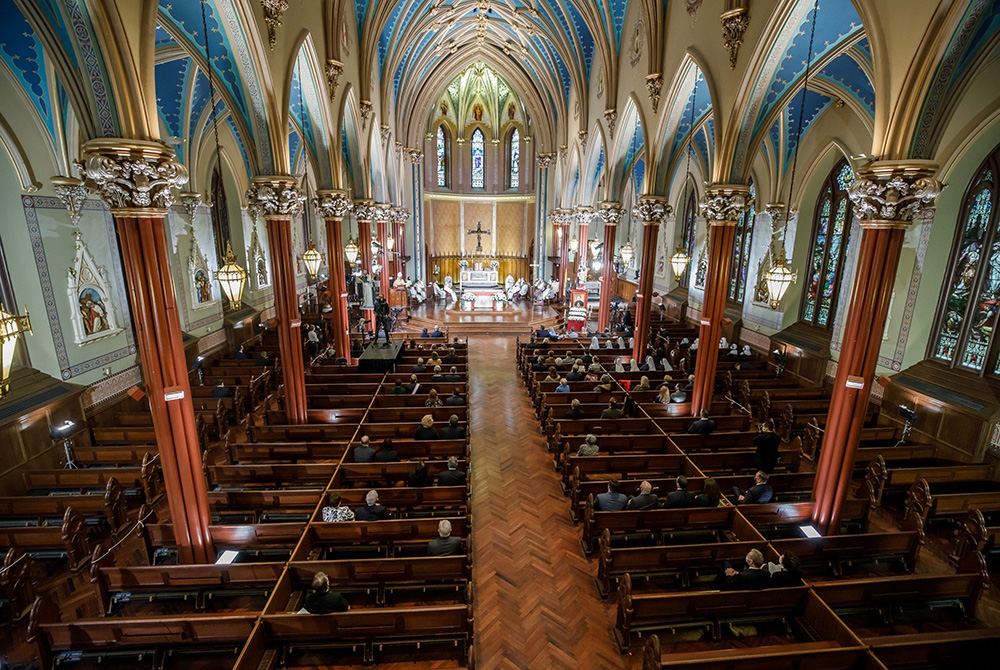
A portrait of Blessed Michael McGivney, founder of the Knights of Columbus, is displayed during a prayer vigil at St. Mary's Church in New Haven, Connecticut, Oct. 30, 2020, the eve of his beatification. (CNS/Courtesy of Knights of Columbus)
When Dominican priests first took up residence at St. Mary's Church in New Haven, Connecticut, Grover Cleveland was president of the United States, Coca Cola was brand new and the Statue of Liberty had just arrived in New York Harbor.
Almost 135 years later, the Archdiocese of Hartford is taking back control of St. Mary's to make it the hub of a new "metropolitan model" that church officials say will be better positioned to serve the spiritual needs of New Haven's now smaller Catholic community.
But the archdiocesan pastoral plan for New Haven has angered parishioners who are not pleased that the Dominicans have to vacate their historic priory, located next to St. Mary's, by Dec. 1. Parishioners have accused the archdiocese of heavy-handedness and not being transparent.
Complicating the matter even further is the fact that St. Mary's also contains the tomb and remains of Blessed Michael McGivney, the 19th-century priest-founder of the global Knights of Columbus. McGivney founded the Knights in the parish during his service there as an assistant pastor. The organization is also headquartered in New Haven.

Supreme Knight Patrick Kelly, second from left, stands with retired Supreme Knight Carl Anderson, Fr. John Paul Walker, pastor of St. Mary's Church in New Haven, Connecticut, and Baltimore Archbishop William Lori after Mass June 11, 2021. Kelly was formally installed as CEO of the Knights during the Mass, celebrated by Archbishop Lori, the Knights' supreme chaplain. In the center is a statue of Blessed Michael McGivney, founder of the Knights. (CNS/Courtesy of Knights of Columbus)
"We understand as the laity that the church, from a financial perspective, needs to make these changes. But the fact that there is such a disheartening dichotomy between diocesan leadership's words about accompaniment and collaborating with us, and their actions in this case, it's very discouraging," said Erika Ahern, a St. Mary's parishioner.
Dominican Fr. John Paul Walker, the current pastor of St. Mary's, told NCR that the news about his religious order leaving the parish has been difficult for his fellow priests and parish staff as well as parishioners to process.
"It's a fair amount of shock, and certainly sadness," Walker said.
The move has revealed some tensions and hard feelings between the Archdiocese of Hartford and the Dominican Friars of the Province of St. Joseph regarding the pastoral plan, the religious order's future in the archdiocese and how the news about St. Mary's became public.
"This has gotten way blown out of proportion," Hartford Archbishop Leonard Blair said on the Oct. 10 episode of his podcast in response to a listener's question about why the archdiocese is removing the Dominican friars from St. Mary's.
"We simply need to do this because of the numbers of priests that are diminishing," said Blair, who added that he was "sorry" to see that "a very complex matter" had "turned out this way."
David Elliott, a spokesman for the Archdiocese of Hartford, told NCR that the controversy has much to do with the archdiocese's communications plan for St. Mary's being "completely upended" by the Dominicans unilaterally announcing the move.
Elliott said the archdiocese and the Province of St. Joseph had agreed to craft a joint announcement regarding St. Mary's, which was to be released in early October. But a few days before the scheduled statement, Elliott said, the Dominicans issued their own press release and posted the announcement on the parish's Facebook page.
"Unfortunately the Dominican friars broke the news about the situation while the entire presbyterate of the archdiocese was away on their yearly convocation, so needless to say we were blindsided by that," Elliott said.

Archbishop Leonard Blair of Hartford, Connecticut, gives the homily as he concelebrates Mass with other U.S. bishops Nov. 4, 2019, at the Basilica of St. Mary Major in Rome. (CNS/Paul Haring)
The failed communications strategy, Elliott suggested, created "an us-versus-them situation" and fueled what he described as "conspiracy theories" regarding the archdiocese's true intentions for St. Mary's.
As for McGivney's remains, Elliott said there "is no truth" to "those rumors" that he said have been "running rampant" that the archdiocese has plans to move McGivney to the Cathedral of St. Joseph in Hartford.
"It's absolutely not something that's being discussed," Elliott said.
Dominican officials recalled a slightly different version of events.
Dominican Fr. Kenneth Letoile, the prior provincial of the Province of St. Joseph, told NCR that the province was "surprised" when the Archdiocese of Hartford notified the Dominicans in September that they would need to leave St. Mary's before year's end.
"It looked to me like this was more of an executive approach to diocesan reorganization, rather than an attempt to do this from the grassroots," said Letoile, who added that the friars at St. Mary's were aware that the archdiocese's pastoral plans could impact them.
"And that in fact is what happened," Letoile said. "They were not completely taken off-guard, but by the same token, this particular approach to archdiocesan planning affected us when we were informed about the plans of the archdiocese."
Elliott said the archdiocese notified the Province of St. Joseph in March about its intentions to make St. Mary's the hub of a new metropolitan model of spiritual care where all ten Catholic churches in New Haven will be merged into one entity. Several of the existing church buildings in the city will be kept open, but priests in New Haven will all live together at St. Mary's priory.
The Knights of Columbus did not respond to several requests for comment on this story.
The next pastor at St. Mary's, who will be appointed by Dec. 1, will be the "moderator," a "first among equals" who will work with the other archdiocesan priests in residence to fulfill various pastoral ministries in New Haven, according to the archdiocese.

Catholics attend a Mass of thanksgiving , Nov. 1, 2020, at St. Mary's Church in New Haven, Connecticut. Baltimore Archbishop William Lori, supreme chaplain of the Knights of Columbus, was the main celebrant of the Mass a day after Blessed Michael McGivney was beatified. (CNS/Archdiocese of Hartford/Aaron Joseph)
The parish restructuring in New Haven is the latest phase in a yearslong pastoral planning reorganization in the Archdiocese of Hartford. In June 2017, the archdiocese merged St. Joseph Church in New Haven with St. Mary's.
"What you read officially and what [the Archdiocese of Hartford] has said, indicates that they have a plan for New Haven, based on the numbers of parishioners, numbers of clergy and how they see is the best way to reorganize New Haven," Letoile said.
In a public letter to Catholics in New Haven, Blair says the parish restructuring is necessary, given demographic changes. In the 19th and early 20th centuries, the archbishop said New Haven, like many cities, was "teeming with immigrant Catholics."
"In the 1930's New Haven was home to over 70,000 Catholics. Today that number is approximately 10,000," said Blair, who wrote that extensive study found St. Mary's campus to be "perfectly situated to be the geographical and spiritual focal point of a municipal model for New Haven."
"With its centralized location and functional rectory space, so much of what needs to be done to serve the Faithful can be most effectively coordinated from the St. Mary's facilities," Blair wrote.
Earlier this year, the archdiocese produced a video offering the Province of St. Joseph three ministry options to keep the Dominican friars active in central Connecticut. One possibility would be for the friars to live and minister at the Basilica of the Immaculate Conception in Waterbury, which Elliott said has a large rectory that could be easily turned into a priory.
The other two options — providing pastoral care to the town of Hamden and being assigned to the former St. Joseph Church, with the understanding that it would be given the status of a shrine — would have had the Dominicans living in a renovated space at St. Joseph. Elliott said the archdiocese contracted an architectural firm to draw up renderings of what the renovations would look like to accommodate the friars' community life.
Letoile, the prior provincial, said the province wanted to review those options for further study at its June 2022 provincial chapter meeting.
"We said we needed to study them further, to reflect on them, to see how any of these three could fit into our community's charism and our province's strategic plan moving forward," said Letoile, who added that at least three friars will remain in the Archdiocese of Hartford to carry out ongoing ministries at Quinnipiac University, the Knights of Columbus and the Monastery of Our Lady of Grace in North Guilford.
With their position that the three options required further study, the Dominican friars "essentially made the decision to leave the archdiocese and relinquish their pastoral care" of St. Mary's, Elliott said.
"We're moving forward with the municipal model because frankly, to present these options and then to be told, 'Well, we'll get back to you in 10 months,' that's not necessarily an agreeable timeline. And I think most people would not accept that timeline," Elliott said.
Advertisement
Meanwhile, caught in the middle are parishioners at St. Mary's who, like Ahern, have grown to appreciate the Dominicans' charism.
"There's been a real spiritual fruitfulness for their presence, and we're so grateful for that," said Ahern, who has helped lead parish novenas and efforts to petition the archdiocese to "come to some kind of agreement" with the Dominicans. Ahern said parishioners' requests to meet with the archbishop have thus far gone ignored.
"It was very painful to hear [Blair's] words on his podcast, knowing that we had reached out to him, in charity and respect," Ahern said, adding that many parishioners have "deep concerns" that the new pastoral structure at St. Mary's will not meet their spiritual needs, such as offering daily Masses and daily confessions.
Elliott said that St. Mary's will remain open as a parish, so "there should be no cause for concern" regarding lay-run ministries and programs.
In the meantime, Walker, the pastor at St. Mary's, said he and his brother Dominican priests are doing their best to arrange for a smooth transfer and to serve their parishioners in the time they have left.
"I think a lot of the parishioners are hurting and sad," Walker said. "They're thankful for the time they've had with the friars, but also wondering exactly what the next era of St. Mary's is going to look like. I think they're eagerly awaiting more information from the archdiocese to know exactly what the vision the archdiocese has for the future of the Catholic municipal parish here in New Haven."




